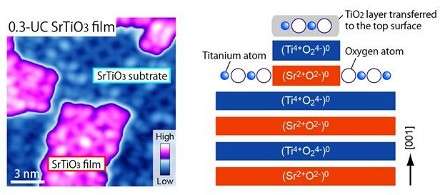Figure 3 from the press release material. (Left) Scanning tunneling microscopy image of 0.3 unit-cell (UC) SrTiO3 thin film (15 nm × 15 nm). Atomic arrangement is clearly observed to be identical between the SrTiO3 thin film (purple) and the SrTiO3 substrate underneath (blue). (Right) A growth model illustrating the formation of SrTiO3 thin film. The TiO2 layer that is present on the surface of the SrTiO2 substrate is transferred to the surface of the thin film.
The research group including AIMR and NIMS developed a new advanced system, combining a super-resolution microscope and a deposition chamber for growing oxide thin films. With this system, they successfully observed for the first time the growing metal-oxide thin films at an atomic level on the surface of single-crystal strontium titanate (SrTiO3). Based on these observations, they identified the mechanism involved in the growth of the thin films in which titanium atoms rise to the surface of the film.
The research group led by assistant professor Takeo Ohsawa (currently the principal investigator at the National Institute for Materials Science [NIMS]) and associate professor Taro Hitosugi at the Advanced Institute for Materials Research (AIMR) of Tohoku University developed a new advanced system, combining a super-resolution microscope and a deposition chamber for growing oxide thin films. With this system, they successfully observed for the first time the growing metal-oxide thin films at an atomic level on the surface of single-crystal strontium titanate (SrTiO3). Based on these observations, they identified the mechanism involved in the growth of the thin films in which titanium atoms rose to the surface of the film.
Metal oxides, including perovskite-type oxides such as SrTiO3, are materials commonly used due to their diverse properties, such as superconductivity, ferromagnetism, ferroelectricity, and catalytic effect. In recent years, novel properties generated at the interface between two dissimilar oxides have been vigorously investigated. However, little has been known about the mechanism involved in the formation of such interface. The understanding of the mechanism is the key to the further improvement of research in this field.
The research group developed an innovative system combining a scanning tunneling microscope capable of identifying individual atoms and a pulsed laser deposition method that enables the growth of high-quality thin films. In addition, they also established a method to prepare a single-crystal SrTiO3 substrate on which atoms are arranged in a periodic pattern. Epitaxial thin films were grown on the surface of the substrates and the growth was observed with atomic-scale spatial resolution. In these observations, they found that there was a great difference in the growth process when SrTiO3 and SrOx thin films were deposited on the surface of the substrates. Furthermore, we identified a phenomenon in which excess titanium atoms present on the surface of the SrTiO3 substrate rose to the surface of the thin film. These observations facilitated the clear atomic-scale understanding of the growth process regarding how oxide thin films are formed. These results may not only contribute to the understanding of the origin of interfacial properties but also lead to the creation of new electronics devices through the development of new functional materials.
This research was carried out as a part of the Japan Science and Technology Agency's Strategic Basic Research Programs and it is due to be published officially in a scientific journal, ACS Nano, in the near future.
Journal information: ACS Nano
Provided by National Institute for Materials Science























